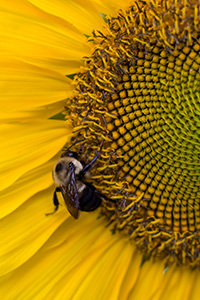Florida’s Keystone Plants

We all know that native plants are a valuable addition to the landscape. However, there is a certain category of native plants that is most crucial: keystone plants. A “keystone” is the center part of an arch. Without it, the arch will crumble. Likewise, the food web will fall apart without keystone plants. Putting it together: keystone plants are the native plants that are deemed essential for upholding the food web.
Supporting Caterpillars
Caterpillars transfer more energy from plants to animals than any other insect. This is why it is important to plant for both the larval and adult stages of pollinators. The caterpillars that don’t turn into butterflies or moths become food for birds (whose populations are sharply declining due in part to a lack of food).
If we’re planting for caterpillars, won’t that mean our plants will become defoliated and unsightly? Luckily, no! If your plant is destroyed by feeding caterpillars, that means those caterpillars don’t have a natural predator to keep their population in check. We’re talking about supporting both native caterpillars and their native predators by growing the keystone plants that are necessary for their continued survival.
Supporting Pollen Specialists

The second reason for planting keystone plants is to support pollen specialists. There are some bees that are generalists, meaning that they visit a variety of plants and are not picky. On the other hand, many of our native bees specialize in the flowers they’ll land on. These specialist bees have adapted over time to perfectly pick up the unique pollen granules of their specific plants.
Think of it this way: planting for generalist bees only benefits them, but planting for specialist bees benefits both them and the generalists. We need both in order to sustain the food web, so adding keystone plants to your pollinator garden will help ensure that specialist bees are not eliminated from the system.
Keystone Plants for Florida
Keystone plants vary by region since the participants in local food webs also vary. They are grouped by genus because there is currently not enough research to specify whether one species within the genus is more beneficial than another.
The National Wildlife Federation has developed helpful handouts for each region of the U.S. that identify the keystone plant genera and the number of caterpillar species and pollen specialists that those plants support. Dr. Doug Tallamy with the University of Delaware and his research team identified these keystone plants in cohort with pollinator conservationist Jarrod Fowler. You can view the resources at the National Wildlife Federation’s Keystone Plants by Ecoregion.
In Florida, we have several trees, shrubs, and flowering perennials that are keystone plants. Florida is home to two ecoregions (each with their own keystone plants), but for these statistics we are focusing only one, ecoregion 15. For trees, the number one keystone plant genus is Quercus (e.g., live oak), since it hosts a whopping 395 caterpillar species. Other keystone tree genera are Prunus (e.g., black cherry), Acer (e.g., red maple), Pinus (e.g., slash pine), Ulmus (e.g., American elm), and Fraxinus (e.g., white ash).
For shrubs, the winning keystone genera is Salix (e.g., coastal plain willow), which hosts 190 caterpillar species. Other important keystone genera are Vaccinium (e.g., blueberry), Rubus (e.g., blackberry), and Baccharis (e.g., saltbush).

Finally, there are several keystone perennials to add to your flower garden. The heaviest lifter is Solidago (e.g., sweet goldenrod), which hosts 82 caterpillars and supports four pollen specialists. Other flowering keystone perennials include Helianthus (e.g., sunflower), Coreopsis (e.g., tickseed), Heterotheca (e.g., camphorweed), Rudbeckia (e.g., black-eyed Susan), Chrysopsis (e.g., Maryland golden-aster), Pityopsis (e.g., narrowleaf silkgrass), Verbesina (e.g., frostweed), and Helenium (e.g., purple-headed sneezeweed).
Look for keystone plants at nurseries that carry native plants. By incorporating some of these plants into your landscape, you can do your part in sustaining our declining insect and bird populations. Plus, you’ll get to enjoy the beauty of Florida’s native flora.
Dr. Doug Tallamy, an entomologist with the University of Delaware, provides excellent resources on keystone plants. You can watch one of his presentations on the National Wildlife Foundation’s website: Native Keystone Plants for Wildlife.
Also on Gardening Solutions
UF/IFAS in the News
- Brevard’s native keystone plants help keep the bird and insect populations healthy — UF/IFAS Horticultural Agent Sally Scalera for Florida Today (May be behind paywall)
- Keystone plants support birds and other wildlife in your yard — UF/IFAS Extension Leon County Master Gardener Volunteer Jody Walthall for the Tallahassee Democrat (May be behind paywall)
Elsewhere
- Narango, D.L., Tallamy, D.W. & Shropshire, K.J. Few keystone plant genera support the majority of Lepidoptera species. Nat Commun 11, 5751 (2020). https://doi.org/10.1038/s41467-020-19565-4
- National Wildlife Federation’s Keystone Plants by Ecoregion
- Native Keystone Plants for Wildlife–National Wildlife Federation
